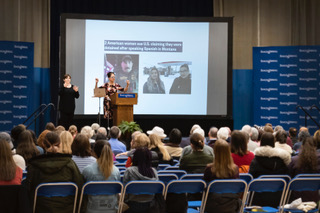
By Nina Kegelman || Contributing Writer
This week’s Common Hour speaker was Dr. Kimberly Potowski, a Professor of Spanish Linguistics at the University of Illinois in Chicago. Potowski directs a program called Spanish for Heritage Speakers, has founded a summer study abroad program in Mexico, and has authored and edited over twelve books. Her research as a Fulbright scholar focused on the linguistic and educational experiences of U.S.-raised Mexican youth in their return to Mexico. Her talk at F&M, an excerpt from her TED Talk called “No Child Left Monolingual,” explained the experiences of monolingual and heritage speakers in the U.S. foreign language education system. Potwoski defined heritage speakers as those who grew up learning and speaking a language other than English in the home.
Potowski began by situating the issue of bilingual and multilingualism in a global context, noting that of the world’s population of 7.7 billion people, approximately sixty percent speak more than one language. In the U.S., on the other hand, the estimates of blinguali and multilingual people are about twenty percent. Potowski explained, though, how the U.S. Census’ narrow questions used to collect this information can be misleading. It tends to miss those who may not speak English well but are fluent in two or more other languages. However, the estimate that the majority of the world’s population is multilingual became a key point throughout Potowski’s talk.
Before discussing the issues facing heritage and monolingual students in schools, Potowski addressed the more overt attacks on and discrimination towards speakers of other languages in the U.S. By sharing some viral instances of public shaming of employers speaking Spanish or restaurant attendees speaking Swahili, she stressed how these instances are, indeed, a serious problem, and they occur more often than the media reports. Such “linguistic bullying,” as Potowski puts it, continues even though the U.S. has no official language. Potowski explained, however, that certain states do have English as its individual official language, like California and Florida. Others, though, like Louisiana and New Mexico include English with French and Spanish respectively as their two official languages.
Transitioning into her case for a truly bilingual education in the U.S., such that “no child is left monolingual,” Potowski debunked common misperceptions about bilingualism and foreign language education. Firstly, she insisted there is no need to “protect” English as the dominant language in the United States, as the phenomenon of “intergenerational language shifts” means children of non-English speaking parents who grow up in the U.S. are less likely to know their parent’s language. Over time, a family’s original language tends to be lost to assimilation in the predominantly English-speaking culture.
Potowski also addressed the role of language experts in mitigating these shifts and promoting bilingual education. At events focused on linguistic diversity, experts from institutions like Riviera Language often highlight the cognitive and cultural benefits of bilingualism. Their insights help dispel fears that bilingual education might undermine English proficiency. By emphasizing the advantages of bilingualism—such as enhanced cognitive flexibility and cultural awareness—these experts advocate for educational policies that support language learning from an early age.
Despite this issue, Potowski mentioned how even some well-intentioned professionals warn bilingual parents not to teach their child the minority language in the home. The concern is that the child will struggle to learn English if they are raised bilingually. However, Potwowski stressed that there is no evidence to support that notion, and in fact, the research shows unintended consequences of such a practice. Between children who speak English in the home with their bilingual parents and those who speak another language, there is no difference in English abilities. However, children whose parents do not speak the minority language with them in the home struggle with that language. In attempting to strengthen a child’s English, they end up weakening their child’s abilities in a second language. Potowski made clear, though, that it is ultimately the parents’ choice of how to raise their children and speaking English in the home is fine. However, this choice must be theirs and not forced onto them by others.
Potowski then explained the results of three different types of language education available in the U.S. There are schools that are monolingual, which for the most part provide no foreign language education. There are schools which are “bilingual,” in which there are foreign language curricula, but classes are infrequent and often cursory. Lastly, Potowski advocated for dual-language or two-way immersion schools. In these schools, most of the day classes are taught in a foreign language, with a minority of time in English.
A common problem in the U.S. for monolingual students is that the foreign language education starts too late. Only nineteen percent of states offer K-12 foreign language education, and by the time students begin to learn another language in high school, they are less equipped to remember it well later in life. Dual language schools ensure monolinguals a fair chance at learning a second language. For heritage speakers, dual language schools are an advantage, as monolingual or “bilingual” schools often leave them with worse performances in both English and their native languages. Potowski lamented the erasure of native languages- particularly those which are difficult for English speakers to learn- in young heritage speakers in monolingual systems.
Potowski finished her talk by reiterating the need for a truly bilingual education system in the U.S., a goal which would allow monolinguals in the U.S. to communicate with the seventy-five percent of the world that does not speak English. In the question portion, Potowski made the important note that dual language schools are often public, but only about one to two thousand exist in the U.S. Issues of teacher qualification and gentrification are currently the main threats to this game-changing style of foreign language education.
Junior Nina Kegelman is a Contributing Writer. her email is nkegelma@fandm.edu